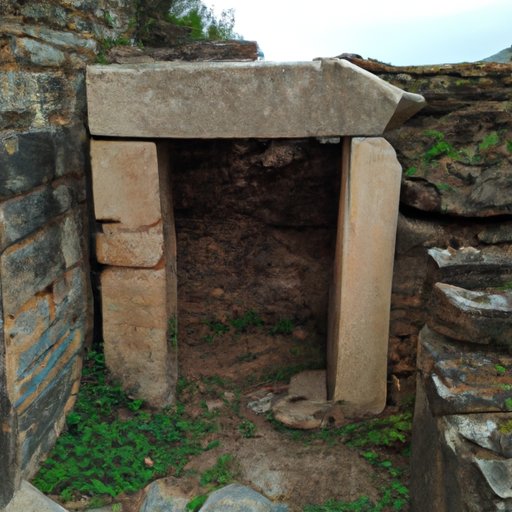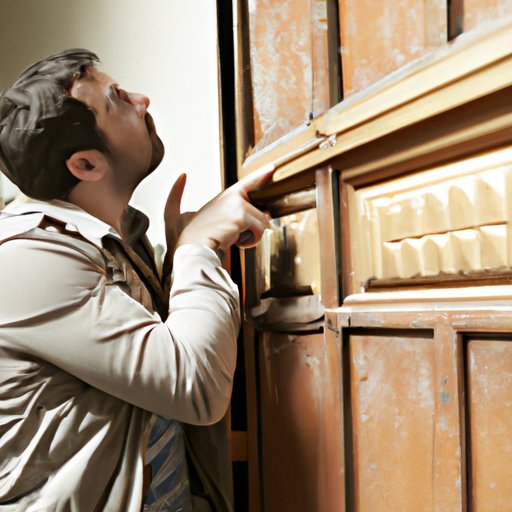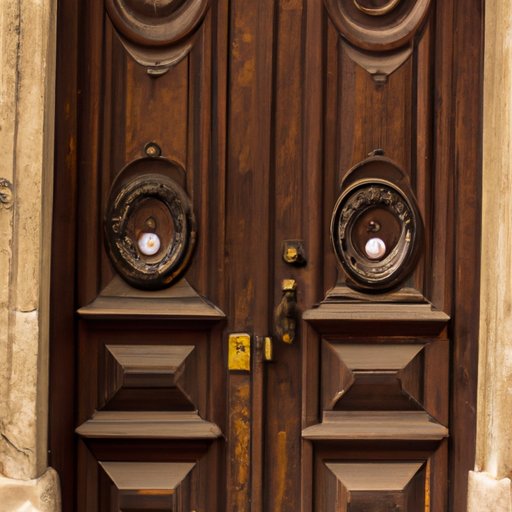Introduction
Doors have been an integral part of human life since time immemorial. As one of the most basic architectural elements, doors are used in virtually every dwelling and building. But when was the first door invented? This article will explore the history of the door and attempt to answer this question.
A door is defined as a movable structure used to open and close off an entrance, typically consisting of a panel that swings on hinges or that slides or rotates inside of a space.
History of the Invention of the Door
In order to understand when the first door was invented, we must look back at the history of the door. The earliest known doors date back to prehistoric times, though these were likely simple openings covered with animal skins or cloths. As humans began to settle in permanent dwellings, more sophisticated doors began to appear.
Early Prehistoric Origins
The earliest known doors were constructed during the Paleolithic period (c. 2.6 million-10,000 BCE). These were rudimentary structures that were probably made of animal hides or woven materials. Doors of this period would have been used to protect against the elements, wild animals, and intruders.
Ancient Egypt
The first wooden doors appeared in Ancient Egypt around 3,000 BCE. These doors were usually carved from wood and adorned with hieroglyphics. They were often used to separate rooms within a larger dwelling. Doors of this period were also sometimes decorated with gold and silver, indicating their importance and value.
Ancient Greece
The Greeks developed more advanced doors during the Classical period (c. 600-323 BCE). These doors were often made of bronze and included intricate designs such as columns, pediments, and other decorative elements. Greek doors were often used to separate public and private areas, with the latter being more elaborately decorated.
Ancient Rome
During the Roman Empire (27 BCE-476 CE), the use of doors spread throughout Europe and North Africa. Roman doors were typically made of wood and featured metal reinforcements for added security. These doors could be locked with a key, a common feature in doors of this period.
Middle Ages
During the Middle Ages (c. 500-1500 CE), the use of doors continued to evolve. Doors of this period were often more ornately carved and decorated, often featuring religious symbols such as crosses or images of saints. They were also commonly painted in bright colors. Doors of this period were often reinforced with iron bars or locks.

Tracking the Evolution of the Door
As time progressed, so did the design and construction of doors. Let’s take a look at how the door has evolved over the centuries.
Medieval Doors
Medieval doors (c. 1000-1400 CE) were typically made of heavy woods such as oak or walnut. These doors were often heavily fortified with metal braces and locks for added security. They were also frequently adorned with carvings of religious symbols or scenes from popular literature.
Renaissance Doors
Renaissance doors (c. 1400-1600 CE) were often more intricately decorated than their medieval counterparts. These doors often featured detailed carvings of figures, coats of arms, or other decorations. These doors were also often painted in bright colors for added effect.
Industrial Revolution Doors
The Industrial Revolution (c. 1760-1840) saw the introduction of mass-produced doors. These doors were often made of cheaper materials such as pine or plywood and were less ornately decorated than their predecessors. These doors were also often designed to be easily installed and removed.
Modern Doors
Modern doors (c. 1940-present) are typically made of steel, aluminum, or other metals. These doors are often more secure than their predecessors, featuring multiple locking mechanisms and other security features. Modern doors are also often designed to be energy-efficient and aesthetically pleasing.

Exploring the Origins of the Door
In order to determine when the first door was invented, we must examine the available archaeological evidence and historical documents. We must also consider folklore and mythology, which can provide clues as to the origin and purpose of the door.
Archaeological Evidence
Archaeological evidence provides important insight into the origins of the door. Excavations of prehistoric settlements have revealed primitive doors made of animal hides or woven materials. These doors were often used to separate living spaces and protect inhabitants from the elements.
Historical Documents
Historical documents allow us to trace the evolution of the door. Ancient texts from Egypt, Greece, and Rome provide evidence of doors made of wood, bronze, and other materials. These texts also provide information about the purpose and function of the door in each culture.
Folklore and Mythology
Folklore and mythology can also provide clues about the origin and purpose of the door. In many cultures, the door is seen as a symbol of protection and hospitality. In some mythologies, doors are associated with gods or deities and are seen as a way to access other realms.
A Timeline of the Development of the Door
Let’s take a look at a timeline of the development of the door, from its prehistoric origins to the present day.
Prehistoric Period
The earliest known doors date back to the Paleolithic period (c. 2.6 million-10,000 BCE). These were rudimentary structures that were probably made of animal hides or woven materials.
Ancient Egypt
Around 3,000 BCE, the first wooden doors appeared in Ancient Egypt. These doors were usually carved from wood and adorned with hieroglyphics. They were often used to separate rooms within a larger dwelling.
Ancient Greece
The Greeks developed more advanced doors during the Classical period (c. 600-323 BCE). These doors were often made of bronze and included intricate designs such as columns, pediments, and other decorative elements.
Ancient Rome
During the Roman Empire (27 BCE-476 CE), the use of doors spread throughout Europe and North Africa. Roman doors were typically made of wood and featured metal reinforcements for added security.
Middle Ages
During the Middle Ages (c. 500-1500 CE), the use of doors continued to evolve. Doors of this period were often more ornately carved and decorated, often featuring religious symbols such as crosses or images of saints.
Renaissance
Renaissance doors (c. 1400-1600 CE) were often more intricately decorated than their medieval counterparts. These doors often featured detailed carvings of figures, coats of arms, or other decorations.
Industrial Revolution
The Industrial Revolution (c. 1760-1840) saw the introduction of mass-produced doors. These doors were often made of cheaper materials such as pine or plywood and were less ornately decorated than their predecessors.
Modern Era
Modern doors (c. 1940-present) are typically made of steel, aluminum, or other metals. These doors are often more secure than their predecessors, featuring multiple locking mechanisms and other security features.

Examining the First Door Ever Made
Now that we have a better understanding of the history of the door, let’s take a closer look at the first door ever made.
Archaeological Findings
Archaeological findings indicate that the first doors were made during the Paleolithic period (c. 2.6 million-10,000 BCE). These doors were likely made of animal hide or other primitive materials and were used to protect against the elements, wild animals, and intruders.
Possible Locations
Due to the nomadic nature of early humans, it is difficult to pinpoint the exact location of the first door. However, archaeological evidence suggests that the first door may have been built in what is now Israel, Syria, or Iraq.
The Ancient Origins of the Door
The door has been an integral part of human life for centuries. Its ancient origins are steeped in symbolism and meaning.
Ancient Beliefs
In many cultures, the door is seen as a symbol of protection and hospitality. In some mythologies, doors are associated with gods or deities and are seen as a way to access other realms.
Symbolic Meanings
The door is also a symbol of transition and transformation. In many cultures, crossing a threshold can represent a new beginning or the start of a journey. The door can also be seen as a barrier between the known and unknown, past and future.
Conclusion
The history of the door is long and complex. While it is difficult to pinpoint exactly when the first door was invented, archaeological evidence indicates that doors were being used as far back as the Paleolithic period (c. 2.6 million-10,000 BCE). Throughout the centuries, the design and construction of doors has evolved, from simple openings covered with animal skins or cloths to modern doors made of steel and other metals.
The door has been an integral part of human life for centuries. Its ancient origins are steeped in symbolism and meaning, representing protection, hospitality, and transition. As the door continues to evolve, its impact on our lives will no doubt continue to be felt for generations to come.
(Note: Is this article not meeting your expectations? Do you have knowledge or insights to share? Unlock new opportunities and expand your reach by joining our authors team. Click Registration to join us and share your expertise with our readers.)
